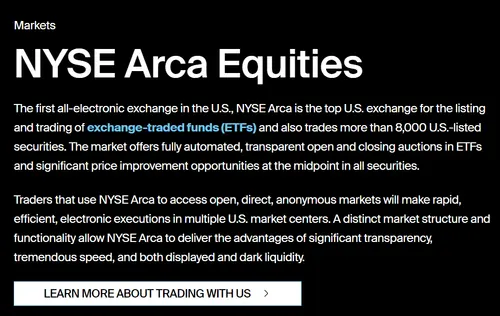Our partner, XM, lets you access a free demo account to apply your knowledge.
No hidden costs, no tricks.

The New York Stock Exchange is perhaps the most popular securities exchange in the world. With the largest combined market capitalization, the exchange is home to 2,400 equities from a wide range of sectors.
In addition to stocks, the exchange also offers hundreds of exchange-traded funds, or ETFs, which are diversified equity investments that function similarly to stocks.
NYSE Arca is the subsidiary exchange of the Intercontinental Exchange, or ICE, which is the parent company of the NYSE.
NYSE Arca acts as a proprietary securities exchange under the ICE umbrella and offers financial and miscellaneous data regarding the ETFs listed on the exchange.
The exchange operates on an electronic platform, allowing for efficient and rapid trading of a wide range of financial instruments.
As part of the broader New York Stock Exchange (NYSE) family, NYSE Arca complements the traditional floor-based trading model of the NYSE with its electronic trading capabilities.
If you are a beginner trader and would like to know more about NYSE Arca and how it operates, this Investfox guide can help.
As NYSE Arca is part of the New York Stock Exchange, it provides investors with access to a diverse array of investment products, facilitating the buying and selling of securities in a transparent and regulated environment.
NYSE Arca, formerly known as the Pacific Exchange (PCX), was founded in 1882. It initially operated as the San Francisco Stock and Bond Exchange.
In 2006, the exchange was rebranded as NYSE Arca in 2006 and integrated into the New York Stock Exchange.
Traders can buy and sell ETFs tracking some of the most popular stock market indices, such as the S&P 500, Nasdaq-100, and the Dow Jones Industrial Average, among many more.
To better understand how the NYSE Arca functions, we can look at the different aspects of the exchange.

Unlike traditional open outcry trading floors, NYSE Arca operates as an all-electronic exchange.
This means that all trading on the platform occurs electronically, providing efficiency and speed in the execution of trades.
In this sense, NYSE Arca is more similar to the Nasdaq than it is to the New York Stock Exchange, which still operates a physical trading floor to this day.
NYSE Arca is particularly known for being a leading exchange for ETFs. It lists and trades a wide range of ETFs covering various asset classes, including equities, fixed income, commodities, and more.
The exchange has played a significant role in the growth and development of the ETF industry, as well as the popularization of electronic trading of ETFs.
NYSE Arca operates on a market model that includes market makers and liquidity providers.
Market makers play a crucial role in maintaining liquidity by quoting bid and ask prices for securities, facilitating trading for investors.
Much like any other securities exchange, traders can access NYSE Arca via regulated brokerages.
Like other securities exchanges in the United States, NYSE Arca is regulated by the U.S. Securities and Exchange Commission (SEC).
It must comply with SEC rules and regulations to ensure fair and transparent trading practices.
This includes AML and policies against insider trading, among many others.
The exchange generates revenue through various channels, such as listing fees, which are charged as one-off and recurring fees. These fees contribute to the exchange's revenue and are based on factors such as the type of security being listed and the issuer's financials.
Furthermore, NYSE Arca also provides market data to institutional investors, which is also done for varying fees based on the data package required by investors.
NYSE Arca charges transaction fees to market participants for executing trades on its platform. These fees can vary based on factors such as the type of security being traded, the volume of trades, and whether the market participant is a liquidity provider or a taker.
Our partner, XM, lets you access a free demo account to apply your knowledge.
No hidden costs, no tricks.
NYSE Arca operates as part of the NYSE Group, a subsidiary of Intercontinental Exchange (ICE). While it functions as its own electronic securities exchange, it is not fully independent, as it falls under the broader structure of the NYSE Group within ICE's holdings.
NYSE Arca is owned by Intercontinental Exchange (ICE), a global exchange operator. ICE acquired NYSE Arca as part of its broader strategy to expand its presence in electronic trading and financial markets, strengthening its position in the exchange industry.
NYSE Arca primarily facilitates electronic trading of exchange-traded funds (ETFs) and other exchange-listed products. Investors can trade a diverse range of ETFs covering equities, fixed income, commodities, and other asset classes on the platform.